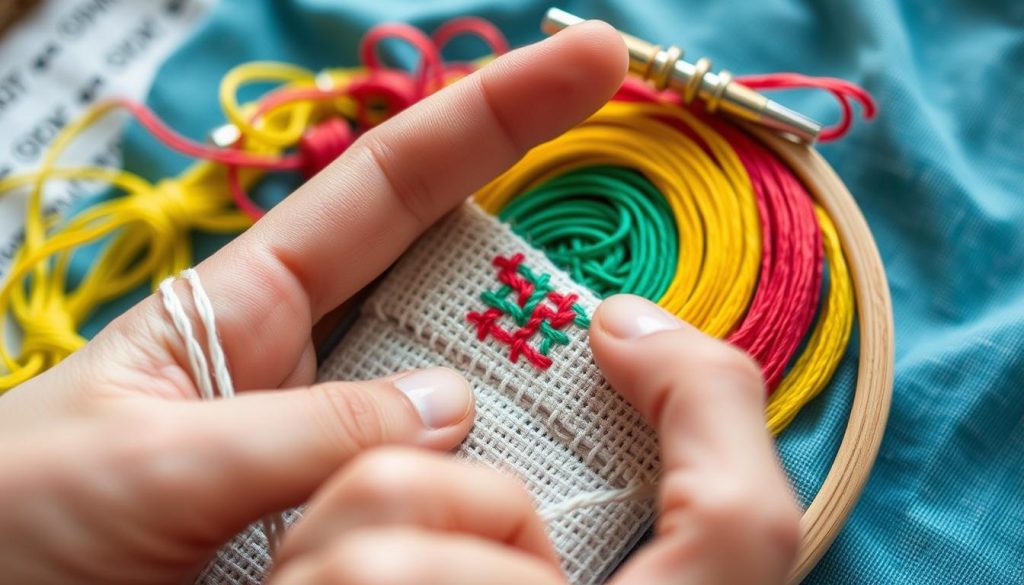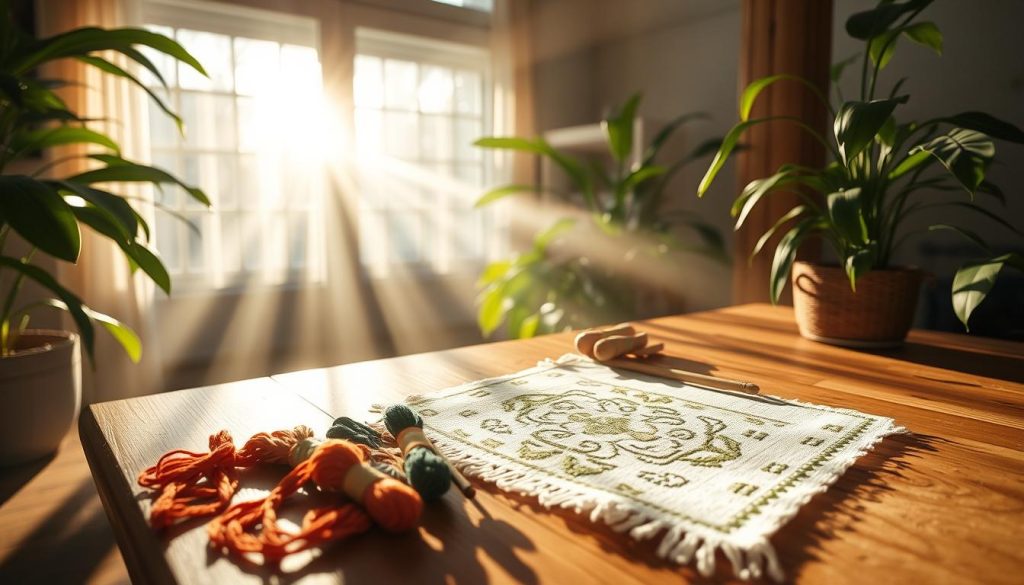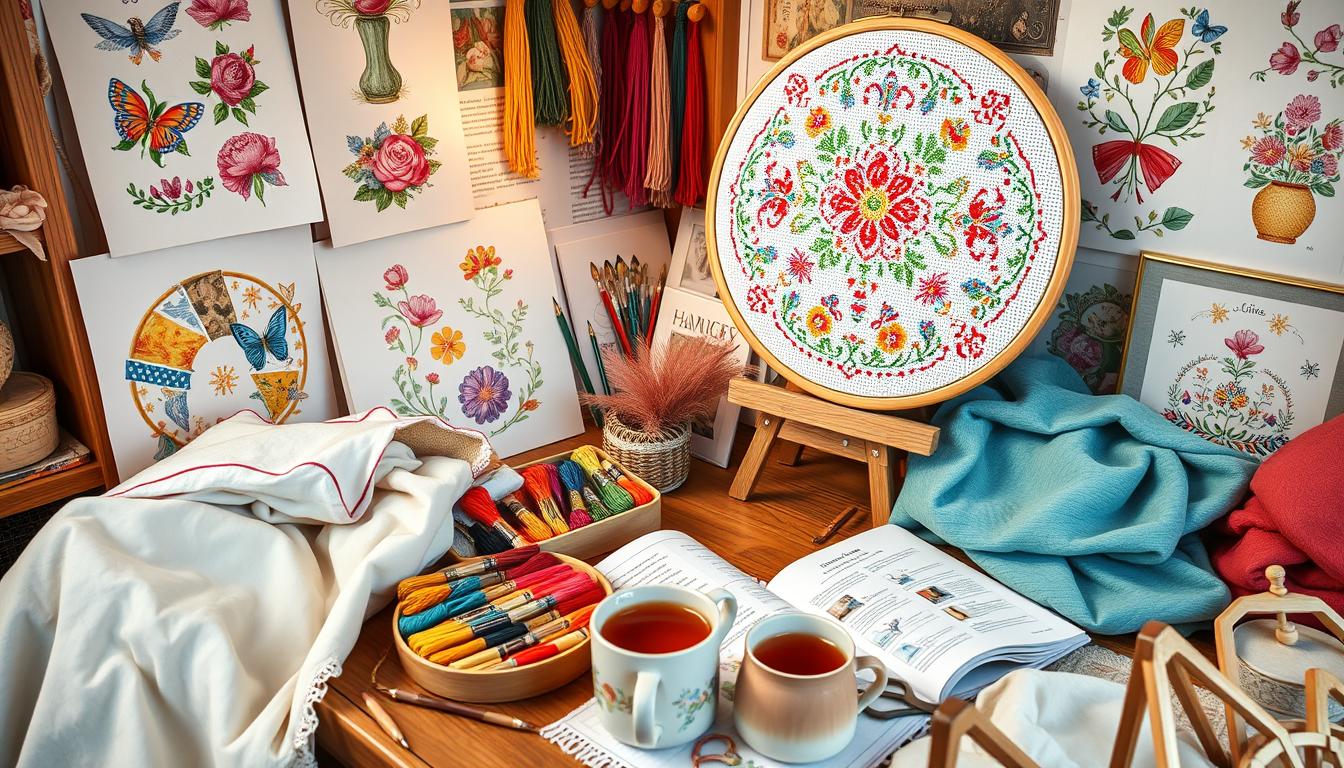Cross stitch fans want to get better and make amazing pieces. It might look simple, but there are many tips and techniques to improve your work. This guide will share the secrets that experts use to stitch perfectly and get top-notch results.
Learning about the right thread and mastering tension and framing can change your projects. Cross stitching is not just about making X-shaped patterns on fabric. It’s an art that can create stunning pieces with the right skills. We’ll look at key practices to save time and avoid mistakes, making your work stand out.
Key Takeaways
- 14 count Aida cloth is recommended for beginners for its ease of use.
- DMC embroidery floss offers 489 different color choices.
- Using 2 threads from a single strand of floss is typical for basic cross-stitching.
- Gridding fabric helps speed up the stitching process.
- Personal preferences for thread brands may develop over time.
Choosing the Right Thread for Your Projects
Choosing the right cross stitch threads is key to making your artwork bright and lasting. The quality of your threads really matters. We’ll look at some tips for picking the best threads for your cross stitch projects.
Understanding Thread Quality
Good cross stitch thread quality makes your work look better and last longer. DMC threads, made from 100% Egyptian cotton, are known for their smooth feel and bright colors. They are a top choice for many stitchers because they stitch smoothly and consistently.
Silk threads are more pricey but great for adding elegance and a lasting shine to your projects.
- Stranded cotton is the most commonly used thread.
- Silk threads add elegance but come at a higher cost.
- Perlé cotton is ideal for Hardanger embroidery.
Thread Length Tips
Managing thread length is important to avoid tangles and frays. Cut your thread to the length from your fingertip to your elbow. This makes stitching easier and helps avoid problems.
For cross stitch threads, especially when using two strands or more, separate and realign them before threading. This keeps your work even and neat.
Using Thread Conditioners
Using a thread conditioner can really improve your stitching, especially with metallic threads. Thread conditioner usage makes threads easier to handle and more durable. It prevents fraying and knotting during long stitching sessions.
Conditioning your threads makes them easier to work with and extends their life. This keeps your artwork looking great for a long time.
Proper Tension Techniques to Avoid Flat Stitches
Keeping the right tension in cross stitch is key for vibrant and dimensional results. This section will show you how to manage tension. This way, your stitches will stay plump and beautiful, not flat and distorted.
Importance of Needle Position
Getting your needle in the right spot is vital to avoid flat stitches. A consistent angle keeps tension even. Most stitchers prefer blunt needles because they slide through fabric smoothly.
This method helps prevent split stitches, a common problem.
Avoiding Pulling Thread Too Tight
One key cross stitch tension tip is not to pull the thread too tight. Tight thread can make stitches flat and dull. About 55% of stitchers struggle with separating six-stranded threads, leading to tight stitches.
Tools like laying tools or railroading can help keep tension even. This prevents twisted stitches and gives a polished look.

Using a hoop or Q-Snap frame is also helpful. In fact, 88% of stitchers find hoops keep stitches even and prevent fabric distortion. Q-Snaps, with their square shape, offer more stitching area for even tension.
Washing your cross stitch project can also puff up the stitches. This makes them denser and more luxurious.
Stitching on higher count fabrics is better for coverage. For example, 16ct or 32ct fabric makes projects smaller but more detailed. Using two strands of floss on these fabrics gives better coverage. But, using three strands on 14ct or 28ct fabric makes the stitches fuller but bulkier.
Regular practice and using these cross stitch techniques can lead to amazing results. It makes your hobby more enjoyable and rewarding.
| Technique | Benefit |
|---|---|
| Needle Positioning | Prevents split stitches and maintains even tension |
| Avoiding Tight Pulls | Prevents flat stitches and ensures vibrant results |
| Using Hoops/Q-Snaps | Helps keep fabric even and prevents distortion |
| Stitching on Higher Count Fabrics | Provides better coverage and more detailed results |
The Benefits of Snipping Loose Threads as You Go
Snipping loose threads keeps your workspace clean. It also stops cross stitch tangling. This makes your stitching smoother and more fun.
Preventing Stitch Tangles
Snipping threads early stops tangling problems. Managing loose threads keeps your stitching neat. This reduces mistakes and makes your stitches last longer.
Creative Uses for Leftover Threads
Use leftover threads for creative projects. Make cards, phone cases, or paperweights. Using leftover threads shows your creativity and is good for the environment.
| Method | Description | Benefit |
|---|---|---|
| Waste Knot or Holding Stitch | Start stitching 2.5cm (1″) from the starting point with two tiny holding stitches. | Prevents thread slippage. |
| Away Knot Method | Knot the thread and start 10cm (4″) from the starting point. | Prevents thread tangles. |
| Stitching Over Method | Secure the thread by stitching over a 2.5cm (1″) tail. | Keeps thread ends secure and neat. |
| Stopping Stitching | Weave the thread under the last few stitches. | Ensures thread ends stay in place. |
Optimizing Cross Stitch Lighting Conditions
Good lighting is key for precise and comfortable stitching. It makes your crafting time more fun and productive. Using natural light and electric lamps together can greatly improve your cross stitch experience.
Stitching in Natural Light
Natural light stitching gives you the best color accuracy. It’s vital for matching thread colors accurately. Plus, it’s good for your health.
Being in natural light boosts serotonin and vitamin D. This improves your mood and brain function. It can also help you sleep better by keeping your body clock in sync.

Place your workspace near a window for the best natural light. But watch out for glare and shadows. Sheer curtains can soften the light, making your workspace perfect for stitching.
Using Lamps and Reading Lights
When natural light isn’t enough, effective cross stitch lamps are key for enhancing visibility. Good electric lighting, like the BlueMax dimmable floor lamps, offers full-spectrum light. This reduces eye strain and fatigue.
Stella Two desk lamps are great for being light and easy to move. They have triple-range LED lighting for different needs:
- Warm light: Great for evening stitching, cuts down on blue light.
- Cool light: Best for daytime, brings out thread colors and details.
- Combination light: Good for any time, balances brightness and color.
For traveling, Mighty Bright clip-on lights are perfect. They’re great for use in cars, planes, or trains. Tools like the Dublin Craft Magnifier and CraftOptics can also improve your setup. CraftOptics are especially useful if you wear glasses, offering both magnification and light.
When choosing electric lighting, look for adjustable settings and blue light filters. Mixing natural and electric light can make your workspace comfortable and efficient for cross-stitching.
Maintaining Aida Cloth and Avoiding Creases
Proper Aida cloth care is key to keeping your cross stitch projects looking great. Knowing how to take care of your fabric ensures your work looks professional. We’ll share tips on avoiding creases and ironing your cross stitch correctly.
Removing Aida from Hoops
Removing the Aida cloth from the hoop after each session is crucial. This prevents creases from setting in. Forgetting to do this can lead to wrinkles that are hard to get rid of. By unwinding the fabric each time, you keep your project looking good and last longer.
Ironing Techniques for Finished Pieces
After finishing a cross stitch, it’s important to remove creases. Here are some ironing tips:
- Ironing on the Backside: Ironing on the back protects the stitches.
- Use a Protective Layer: A towel or cotton cloth helps protect the fabric and threads.
- Adjust Iron Settings: Use low to medium heat to avoid damaging the fabric.
- Steam and Damp Methods: Steam or dampen the cloth for tough wrinkles. Hanging it in a steamy bathroom can also help.
Here are some practical tips:
| Action | Best Practice |
|---|---|
| Removing Aida from Hoop | Do this after each session to avoid creases. |
| Ironing Technique | Iron on the backside with a protective layer and avoid metallic threads. |
| Steam and Damp Methods | Use steam or damp cloth for stubborn creases, but don’t overdo it. |
| Iron Settings | Use low to medium heat to avoid damage. |
Following these tips ensures your cross stitch looks professional and crease-free. Your projects will always be ready to impress.
Advanced Cross Stitch Framing and Display Tips
Mastering cross stitch framing is key to showcasing your art. Proper framing preserves your work and highlights it beautifully. Here are some advanced tips for professional cross stitch display to make your pieces stand out:
Choosing the right frame size is crucial when displaying cross stitch creations. The frame’s proportions should complement your work. Using colors and textures that match your artwork adds depth and interest.
Mattings are often overlooked in cross stitch decoration. They protect your artwork from damage and add a visual border. Choose acid-free mats to prevent yellowing over time.
The type of glass used in cross stitch framing matters. Museum-quality glass reduces glare and protects from UV damage. Non-reflective glass is also good but less expensive.
Proper mounting is essential. Use mounting boards made for textiles to avoid damage. Stretch your work evenly to prevent wrinkles. Secure the fabric at the back instead of using adhesives.
The following table summarizes key considerations for cross stitch framing and display:
| Aspect | Recommendations |
|---|---|
| Frame Size | Choose size that complements your work |
| Matting | Use acid-free mats to prevent yellowing |
| Glass Type | Opt for museum-quality or non-reflective glass |
| Mounting | Use textile mounting boards and avoid adhesives |
Using these professional cross stitch display techniques will elevate your work. With careful selection of frames, mats, and glass, your cross stitch pieces will look stunning. They will be a gallery-quality finish, lasting for years.
Conclusion
Mastering cross stitching is a mix of planning and creativity. Choosing the right thread is key for bright colors and avoiding tangles. Tips on thread care and length can make your project better.
Keeping the right tension is also important. It stops stitches from looking flat and makes your work look better. Paying attention to needle placement and not pulling too hard is crucial for good stitching.
Being proactive about cutting loose threads and using leftover materials helps avoid tangles and waste. A good lighting setup also helps, making sure every detail is precise.
Looking after your Aida cloth and learning to frame your work shows you care about quality. These steps turn your stitching into art, making each project a source of pride.
But cross stitching is more than a hobby. It’s a way to relax and improve your mental health. Joining stitching groups can teach you new things and connect you with others who love stitching. Keep practicing and enjoy the process of making beautiful art from threads.
